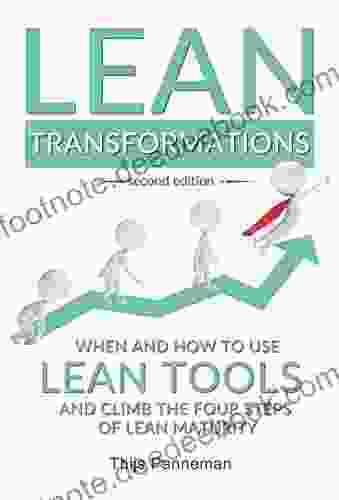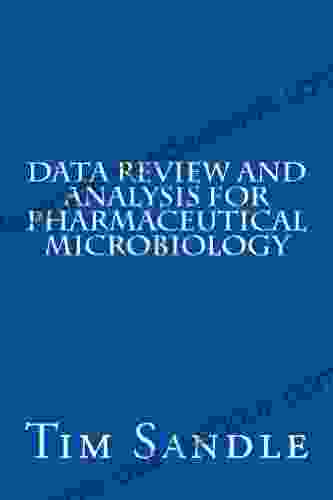Data Review and Analysis for Pharmaceutical Microbiology: A Comprehensive Guide

4.3 out of 5
| Language | : | English |
| File size | : | 22128 KB |
| Text-to-Speech | : | Enabled |
| Screen Reader | : | Supported |
| Enhanced typesetting | : | Enabled |
| Word Wise | : | Enabled |
| Print length | : | 745 pages |
Data review and analysis is a critical step in pharmaceutical microbiology. It allows scientists to identify trends, patterns, and outliers in the data, and to make informed decisions about the quality and safety of pharmaceutical products.
The process of data review and analysis typically involves the following steps:
- Data collection: The first step is to collect the data that will be reviewed and analyzed. This data can come from a variety of sources, including clinical trials, manufacturing records, and quality control tests.
- Data cleaning: Once the data has been collected, it must be cleaned before it can be analyzed. This involves removing duplicate data points, correcting errors, and normalizing the data.
- Data analysis: The next step is to analyze the data. This can be done using a variety of statistical techniques, including descriptive statistics, inferential statistics, and machine learning.
- Data interpretation: The final step is to interpret the results of the data analysis. This involves drawing s about the quality and safety of the pharmaceutical product.
Data review and analysis is a complex process, but it is essential for ensuring the quality and safety of pharmaceutical products. By following the steps outlined above, scientists can ensure that the data they are using is accurate, reliable, and informative.
Data Collection
The first step in data review and analysis is to collect the data that will be used. This data can come from a variety of sources, including:
- Clinical trials: Clinical trials are conducted to evaluate the safety and efficacy of new pharmaceutical products. The data collected from clinical trials can be used to identify trends in the safety and efficacy of the product, and to make decisions about whether or not to approve the product for marketing.
- Manufacturing records: Manufacturing records document the steps involved in the manufacturing process of pharmaceutical products. This data can be used to identify potential sources of contamination or other problems in the manufacturing process.
- Quality control tests: Quality control tests are performed to ensure that pharmaceutical products meet the required standards for safety and quality. The data from quality control tests can be used to identify batches of product that do not meet the required standards, and to take corrective action.
Once the data has been collected, it is important to ensure that it is accurate and reliable. This can be done by verifying the data against the original source documents, and by checking for errors.
Data Cleaning
Once the data has been collected, it must be cleaned before it can be analyzed. This involves removing duplicate data points, correcting errors, and normalizing the data.
- Removing duplicate data points: Duplicate data points can occur when the same data is recorded multiple times. This can be due to a variety of reasons, such as human error or data entry errors. Duplicate data points can be removed using a variety of methods, such as sorting the data and identifying duplicate values, or using a data cleaning tool.
- Correcting errors: Errors can occur in the data due to a variety of reasons, such as human error or data entry errors. Errors can be corrected by verifying the data against the original source documents, and by using data cleaning tools.
- Normalizing the data: Normalizing the data involves converting the data to a common scale or format. This makes it easier to compare the data and to identify trends and patterns.
Data cleaning is an important step in data review and analysis. By cleaning the data, scientists can ensure that the data they are using is accurate, reliable, and informative.
Data Analysis
The next step in data review and analysis is to analyze the data. This can be done using a variety of statistical techniques, including:
- Descriptive statistics: Descriptive statistics provide a summary of the data, including the mean, median, mode, and standard deviation. These statistics can be used to identify trends and patterns in the data, and to make comparisons between different groups.
- Inferential statistics: Inferential statistics allow scientists to make inferences about the population from which the data was collected. These statistics can be used to test hypotheses about the population, and to make predictions about the future.
- Machine learning: Machine learning is a type of artificial intelligence that can be used to analyze data and identify patterns. Machine learning algorithms can be used to develop predictive models, and to identify outliers in the data.
The choice of statistical technique depends on the type of data that is being analyzed, and the goals of the analysis. By using the appropriate statistical techniques, scientists can extract valuable insights from the data, and make informed decisions about the quality and safety of pharmaceutical products.
Data Interpretation
The final step in data review and analysis is to interpret the results of the analysis. This involves drawing s about the quality and safety of the pharmaceutical product.
When interpreting the results of the analysis, it is important to consider the following factors:
- The statistical significance of the results: The statistical significance of the results refers to the probability that the results are due to chance. A statistically significant result is one that is unlikely to occur by chance.
- The clinical significance of the results: The clinical significance of the results refers to the impact of the results on the health of patients. A clinically significant result is one that is likely to have a meaningful impact on the health of patients.
- The totality of the evidence: The totality of the evidence refers to all of the evidence that is available about the quality and safety of
4.3 out of 5
| Language | : | English |
| File size | : | 22128 KB |
| Text-to-Speech | : | Enabled |
| Screen Reader | : | Supported |
| Enhanced typesetting | : | Enabled |
| Word Wise | : | Enabled |
| Print length | : | 745 pages |
Do you want to contribute by writing guest posts on this blog?
Please contact us and send us a resume of previous articles that you have written.
 Book
Book Text
Text Story
Story Reader
Reader Library
Library E-book
E-book Newspaper
Newspaper Paragraph
Paragraph Sentence
Sentence Glossary
Glossary Bibliography
Bibliography Preface
Preface Annotation
Annotation Manuscript
Manuscript Scroll
Scroll Codex
Codex Tome
Tome Classics
Classics Narrative
Narrative Biography
Biography Dictionary
Dictionary Thesaurus
Thesaurus Character
Character Resolution
Resolution Librarian
Librarian Catalog
Catalog Borrowing
Borrowing Stacks
Stacks Archives
Archives Scholarly
Scholarly Academic
Academic Journals
Journals Reading Room
Reading Room Rare Books
Rare Books Special Collections
Special Collections Interlibrary
Interlibrary Literacy
Literacy Thesis
Thesis Dissertation
Dissertation Theory
Theory Debbie Magids
Debbie Magids Thomas Harris
Thomas Harris James Morton
James Morton Rick Auger
Rick Auger Doug Most
Doug Most Raymond C Floyd
Raymond C Floyd Daniel Philpott
Daniel Philpott C R Jane
C R Jane Ethan Rutherford
Ethan Rutherford Klaus Dodds
Klaus Dodds Bilingual Edition Kindle Edition
Bilingual Edition Kindle Edition N T P Murphy
N T P Murphy Peter Brennan
Peter Brennan Craig Shirley
Craig Shirley Jenni Rickard
Jenni Rickard Michael Hofmann
Michael Hofmann Tony Kushner
Tony Kushner Rodford Edmiston
Rodford Edmiston Peter L Bonate
Peter L Bonate Derek Sayer
Derek Sayer
Light bulbAdvertise smarter! Our strategic ad space ensures maximum exposure. Reserve your spot today!

 John SteinbeckDear Hank Williams: A Haunting and Heartbreaking Tale of a Boy and His Lost...
John SteinbeckDear Hank Williams: A Haunting and Heartbreaking Tale of a Boy and His Lost... Richard WrightFollow ·13.8k
Richard WrightFollow ·13.8k Wayne CarterFollow ·3.2k
Wayne CarterFollow ·3.2k Thomas HardyFollow ·2.5k
Thomas HardyFollow ·2.5k Neil ParkerFollow ·16.9k
Neil ParkerFollow ·16.9k Jeffrey CoxFollow ·9.5k
Jeffrey CoxFollow ·9.5k Jim CoxFollow ·19.6k
Jim CoxFollow ·19.6k Dallas TurnerFollow ·3.6k
Dallas TurnerFollow ·3.6k Miguel NelsonFollow ·2.5k
Miguel NelsonFollow ·2.5k

 Allen Ginsberg
Allen GinsbergUnveiling the True Meaning of Enough: A Comprehensive...
: In the relentless pursuit of progress and...

 Clay Powell
Clay PowellHawker Hunter: The Jet Fighter that Shaped British...
Nestled in the halls of aviation...

 Alec Hayes
Alec HayesWhen and How to Use Lean Tools and Climb the Four Steps...
Lean is a management...

 Trevor Bell
Trevor BellVolume of Charlotte Mason Original Homeschooling: A...
Charlotte Mason's original...

 John Parker
John ParkerAscending Tristan da Cunha: A Comprehensive Guide to...
Prepare yourself for an extraordinary journey...
4.3 out of 5
| Language | : | English |
| File size | : | 22128 KB |
| Text-to-Speech | : | Enabled |
| Screen Reader | : | Supported |
| Enhanced typesetting | : | Enabled |
| Word Wise | : | Enabled |
| Print length | : | 745 pages |












